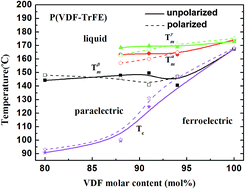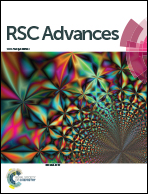A crystal phase transition and its effect on the dielectric properties of a hydrogenated P(VDF-co-TrFE) with low TrFE molar content
Abstract
Hydrogenated P(VDF-co-TrFE)s with low TrFE molar contents were synthesized by atom transfer radical chain transfer (ATRCT) and controllable hydrogenation reactions. By using FTIR, XRD, and DSC techniques, the crystal composition was evaluated which largely depends on the TrFE content and electric field. Accordingly to explain the ferro- to paraelectric phase transition phenomenon at different electric fields, a phase diagram of hydrogenated P(VDF-co-TrFE) was drawn. Interestingly, we found that hydrogenated P(VDF-co-TrFE) with a low TrFE molar content of 9% possesses about half of all-trans beta phase in its crystal region, which is different from early reported copolymerized P(VDF-co-TrFE) with the same composition. Meanwhile, the effect of the field induced crystal structure on its ferroelectric property was depicted by dielectric spectra and displacement-electric field curves. As a result, a favourable remnant polarization of 9 μC cm−2 and a large piezoelectric value of −25 pC N−1 were obtained in a polarized hydrogenated P(VDF-co-TrFE) 80/20 mol% film, which provides a reliable result for the structure design of this kind of copolymer aiming at piezoelectric sensors and generators.


 Please wait while we load your content...
Please wait while we load your content...